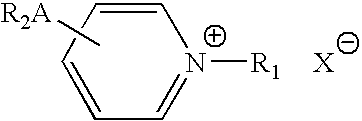Delivery of a substance to a pre-determined site
a predetermined site and substance technology, applied in the field of biotechnology, can solve the problems of limiting the applicability of substances, unable to give a complete list of all possible applications, and substances with far from ideal properties, so as to increase the membrane tension, reduce damage, and increase the overexpression of channel proteins
- Summary
- Abstract
- Description
- Claims
- Application Information
AI Technical Summary
Benefits of technology
Problems solved by technology
Method used
Image
Examples
example 1
Use of Channel-Containing Liposomes as Delivery Vehicles for the Controlled Release of Drugs
example 1-a
MscL-Containing Liposomes as Drug Delivery Vehicles
Material and Methods
MscL Expression and Purification
[0298]E. coli PB104 cells containing the plasmid pB104 carrying the MscL-6His construct was grown to mid-logarithmic phase in Luria Bertani medium (10 L fermentor) and induced for four hours with 0.8 mM IPTG (P. Blount, et al., 1996, EMBO J. 15:4798-4805). Cells were French-pressed and membranes were isolated by differential centrifugation, as previously described (I. T. Arkin, et al., 1998, Biochim. Biophys. Acta. 1369:131-140). The membrane pellet (5-8 g wet weight) was solubilized in 100 mL of buffer A (50 mM Na2HPO4.NaH2PO4, 300 mM NaCl, 10 mM imidazole) containing 3% n-octyl-β-glucoside. The extract was cleared by centrifugation at 120,000×g for 35 minutes, mixed with 4 mL (bed volume) Ni2+-NTA agarose beads (Qiagen, Chatsworth, Calif.) equilibrated with buffer A and gently rotated for 15 minutes (batch loading). The column material was poured into a Bio-Spin column (Bio-...
example 1-b
Light-Switchable Opening of the MscL Channel; Conjugation with DTCP1
[0320] Photo-reactive compounds can be designed to react with MscL-mutant G22C and respond to the absorption of light by changing the local charge or hydrophobicity. An example of such a photo-reactive molecule is 4-{2-(5-(2-Bromo-acetyl)-2-methyl-thiophen-3-yl)-cyclopent-1-enyl}-5-methyl-thiophene-2-carboxylic acid (DTCP 1).
Materials and Methods
[0321] MscL-mutant G22C was overexpressed, purified, labeled, and membrane reconstituted as described in Example 1-C and E.
2-chloro-5-methylthiophene (8) (L. N. Lucas, et al., 1998, Chem. Commun. 2313-2314)
[0322] Suspension of N-chlorosuccinimide (75.9 g, 0.568 mol) and 2-methylthiophene (50 ml, 50.7 g, 0.516 mol) in a mixture of benzene (200 ml) and acetic acid (200 ml) was stirred 30 minutes at room temperature and then one hour at reflux temperature. Cooled mixture was poured into aq. NaOH (3 M, 150 ml), organic phase washed with NaOH (3M, 3×150 ml), dried over Na...
PUM
| Property | Measurement | Unit |
|---|---|---|
| pH | aaaaa | aaaaa |
| conductance | aaaaa | aaaaa |
| magnetic field | aaaaa | aaaaa |
Abstract
Description
Claims
Application Information
 Login to View More
Login to View More - R&D
- Intellectual Property
- Life Sciences
- Materials
- Tech Scout
- Unparalleled Data Quality
- Higher Quality Content
- 60% Fewer Hallucinations
Browse by: Latest US Patents, China's latest patents, Technical Efficacy Thesaurus, Application Domain, Technology Topic, Popular Technical Reports.
© 2025 PatSnap. All rights reserved.Legal|Privacy policy|Modern Slavery Act Transparency Statement|Sitemap|About US| Contact US: help@patsnap.com



